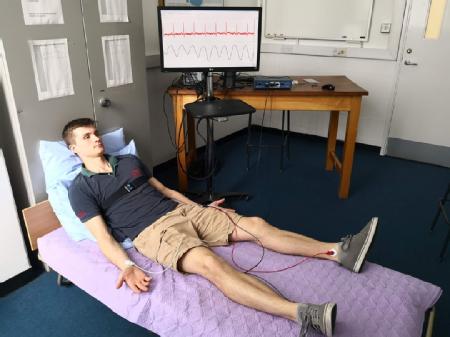Cardio-respiratory synchronization may represent a new measure of health and fitness
· The knowledge of the cardio-respiratory relationship has been expanded by researchers from the School of Engineering at the University of Warwick.
· They have reliably demonstrated cardio-respiratory synchronization, specifically when a single heart beat occurs for each breath.
· Differences have been noted between athletes and non-athletes, potentially indicating a future application for measurement of this phenomenon.
Observation of extended episodes of one-to-one synchronization between heart rate and breathing rate for athletes suggests their training specifically contributes to an enhanced connection within the nervous system.
Researchers from the School of Engineering at the University of Warwick have managed to expand the knowledge of  the cardio-respiratory system after conducting an experiment measuring heart rate during fast-paced breathing.
the cardio-respiratory system after conducting an experiment measuring heart rate during fast-paced breathing.
Published in Scientific Reports, the paper 'Control of heart rate through guided high-rate breathing' shows how researchers found it is possible to reliably observe a one-to-one relationship between heart beats and breaths, when breathing is controlled at a speed exceeding resting heart rate.
Researchers classified participants’ fitness based upon intensity of physical activity. Regular exercise requiring rhythmic breathing, such as swimming or rowing, was suggested to enhance the connection between breathing and heart rate, both muscularly and in the nervous system. Participants were all over 18, with an almost equal spread of male and female.
The experiment required lying in a bed and watching a computer-generated metronome to guide breathing. An initial measurement of heart rate when the participant arrived determined the required metronome speeds for guiding breathing, intended to first match and then exceed their heart rate.
Heart rate was rarely seen to synchronize with breathing when rates should be equivalent, and often increased disproportionately. However, when the frequency of breathing was increased further, heart rate was seen to rise just sufficiently to synchronize the two systems. A one-to-one interaction was observed for all participants in the study.
Athletes in the study naturally found the elevated breathing rate easier to maintain, potentially due to pre-existing experience in rhythmic breathing. The results show that athletes consistently experienced cardio-respiratory synchronization for longer periods, alluding to both the greater influence of a stronger mechanical relationship (heart muscles and lung capacity) and enhanced communication within the nervous system.
It is well understood that when periodic systems interact in a one-to-one relationship, the strength of the relationship is increased. The observation of heart rate increasing to synchronize with the elevated breathing rate during the experiments suggests that the cardio-respiratory system and its control centres in the brain respond in a similar way. It follows that if cardio-respiratory synchronization is more reliably observed in athletes, then the strength of the relationship between breathing and heart rate is greater for these individuals.
With the rise in popularity of fitness training and the increased accessibility of heart rate monitors, these results have potential application in monitoring physiological health over time. Sean Perry, of the School of Engineering at the University of Warwick, comments:
“Cardio-respiratory synchronization provides a potential alternative method for categorising the health of a person’s nervous system. Using non-invasive sensors, the strength of the interaction between breathing and heart rate can be measured during guided breathing regimes. Further investigation of this phenomenon could yield benefits for fitness monitoring, in a similar way to heart rate variability.”
ENDS
19 JULY 2019
NOTES TO EDITORS
High-res images available at: https://warwick.ac.uk/services/communications/medialibrary/images/july2019/sean_p.jpg
Paper available to view at: https://www.nature.com/articles/s41598-018-38058-5
For further information please contact:
Alice Scott
Media Relations Manager – Science
University of Warwick
Tel: +44 (0) 2476 574 255 or +44 (0) 7920 531 221
E-mail: alice.j.scott@warwick.ac.uk
For further information please contact:
Alice Scott
Media Relations Manager – Science
University of Warwick
Tel: +44 (0) 2476 574 255 or +44 (0) 7920 531 221
E-mail: alice.j.scott@warwick.ac.uk
